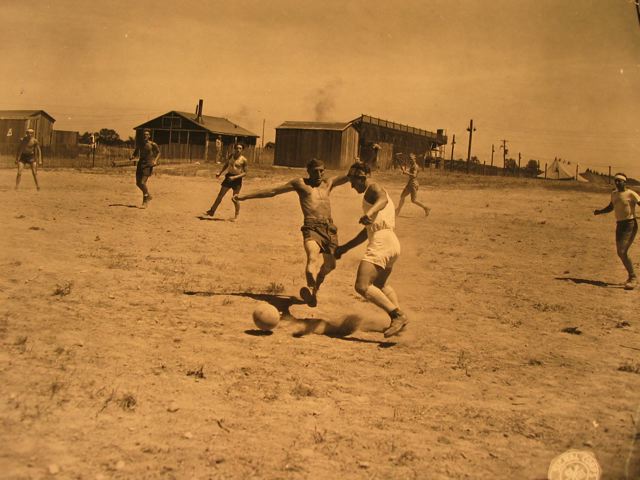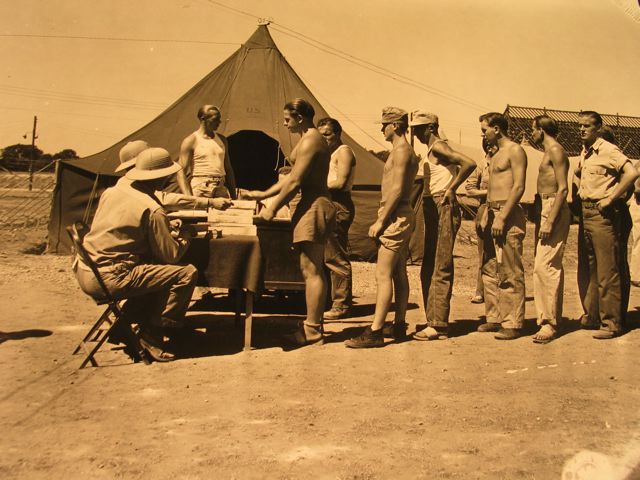
Photo courtesy of the National Archives. "German Prisoners of War, at a sidecamp in Michigan, are pictured here playing soccer; their chief form of outdoor recreation." 8-8-44 Photographer Sgt. A.L. Hertel
In 1944 and 1945, German prisoners of war were housed in a camp 5 1/2 miles west of Owosso near the intersection of M-21 and Carland Road, presently the site of the Owosso Speedway. "Camp Owosso" consisted of a fenced compound with tents pitched in rows. Normally, each tent held six prisoners.
Most of the prisoners at the Owosso camp in 1944 had been captured in North Africa. By 1945, men from the European theater, particularly Italy, were also housed there. It is estimated that between 200 to 1,000 prisoners were held at this camp. An exact number is not known as all POW records were returned to Germany, and the camp administrative records were disposed of in the 1950's.
Under provisions of the Emergency Farm Labor Act, POW labor could be used on nearby farms and in cannery plants. The principal contractor with the government for prison labor was the W. R. Roach Canning Company, but when not needed there, groups could be hired by local farmers for the prevailing farm wage. Of that money, 80 cents per day was given to the prisoners in canteen checks while the rest (about 52 cents per hour) went to the federal government to maintain the camp. A typical work day was 8 to 10 hours long, and, generally, they worked six days per week.
While officially the local people were not supposed to fraternize with the prisoners, many of the farmers would feed them lunch, and some remained friends even after the war ended. The government supplied them with a couple of slices of bread and either a piece of meat or cheese for lunch, but this was inadequate for many of the men doing manual labor. Often, the farmer and his wife would include the POWs with the family for their noon meal.
There were few reported problems with the POW labor once the language barrier was surmounted. Some local people felt that the men preferred being prisoners to fighting in the war. Many of them were not Nazis, but they had been forced to fight in Hitler's army. All they wanted was to go back home.
While in most reports the men were described as "well-behaved", at least two escape attempts were reported in the local newspaper. The first, in July 1944, involved two girls, Kitty Case and Shirley Druce, aged 20 and 19 respectively, who helped two men escape from the W. R. Roach Canning Company where they worked. All four spent the night in the woods near Colby Lake in Woodhull Township before being captured by the Sheriff's department and Michigan State Police the following morning.
At first, the girls considered their actions to be a joke until they learned that they might be tried for treason and face the death penalty. In January of 1945, they were found guilty of conspiracy in Bay City's Federal Court and faced a possible sentence of up to 2 years in prison. Both girls admitted making arrangements to meet the two men, Gottfried Hobel and Eric Classen (both 20 years old), and Kitty Case testified that she was in love with one of the men. A month after the conviction, they were sentenced. Kitty Case received one year and three months while Shirley Druce was sentenced to one year and a day.
The second escape attempt , a month later, also involved Hobel and Classen. Along with Heinz Sauer and Werner Adam, they walked away from two different farms, one in Gratiot County near Bannister and the other south of St. Johns. All were captured and returned to the camp within a couple of days.
There was also at least one instance of the POWs helping the community in an unexpected way. On July 6, 1945, they carried a woman out of a burning building. Mrs. Eva (Frank) Worthington had been released from Memorial Hospital after giving birth to her tenth child, a daughter. Her husband was the superintendent of the Roach Canning Factory and was working at the time of the fire. Mrs. Worthington was awakened when several of the POWs entered the house, wrapped her in her mattress, and carried her to safety. The POWs also salvaged some of the family's belongings and helped fight the fire. Gary Slaughter later fictionalized this event in his book Cottonwood Summer.
Bibliography
"For POWs at Owosso, Farm Work Sometimes Provide (Food) Benefits." Flint Journal: May 25, 1986, pp. A-1f.
"Four Nazis Flee Guards." Owosso Argus-Press: August 16, 1944, p.1.
"As Girls Were Arraigned on Conspiracy Charge." Owosso Argus-Press: July 26, 1944, p. 1.
"Captured Nazis Are Still Enemies." Owosso Argus-Press: July 22, 1944, p.4.
"Girls Arrested Again in Escape of Prisoners." Owosso Argus-Press: July 25, 1944, p.1.
"Girls Cases Before Grand Jury Tomorrow." Owosso Argus-Press: December 27, 1944, p.1.
"Girls May Face Treason Charge in Nazi Escape." Owosso Argus-Press: July 23, 1944, p. 1.
"Girls to Go on Trial Friday." Owosso Argus-Press: January 2, 1945, p. 1.
"Jury Convicts Owosso Girls of Conspiracy." Owosso Argus-Press: January 13, 1945. p. 1.
"Nazi Prison Camp is Model of Neatness." Owosso Argus-Press: Sept. 16, 1944, p. 3.
"Owosso Girls Get Terms in Federal Prison." Owosso Argus-Press: February 13, 1945, p. 1.
"Owosso Woman Was Saved by POWs." Argus-Press: April 24, 1994, p. C-4.
"POW Camp West of Here Closed." Argus-Press: December 1, 1945, p. 1.
"Penalty for Foolishness Should Serve As Warning." Owosso Argus-Press: July 26, 1944, p. 4.
"Prison Camp is Closed Today." Owosso Argus-Press: Oct. 4, 1944, p. 3.
"Private Bitter on War Prisoners." Owosso Argus-Press: February 2, 1945, p. 4.
"Relatives of Girls Testify Against Them." Owosso Argus-Press: January 10, 1945, p. 1.
"Trial of Girls to End Today at Bay City." Owosso Argus-Press: January 12, 1945, p. 1.
"War Prisoners Aided by Girls, Flee, Caught." Owosso Argus-Press: July 21, 1944, p. 1.
"War Prisoners Available." Owosso Argus-Press: July 20, 1944, p. 1.
"War Prisoners Rescue Woman As Home Burns." Owosso Argus-Press: July 7, 1945, p. 1.
"War Prisoners to Be Brought Here to Work." Owosso Argus-Press: May 24, 1944, p. 1.
